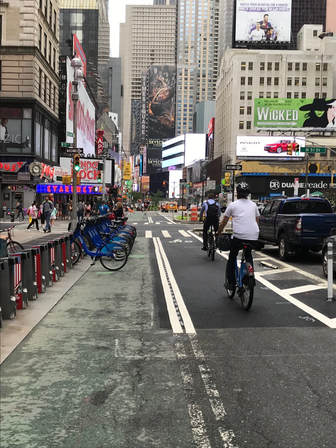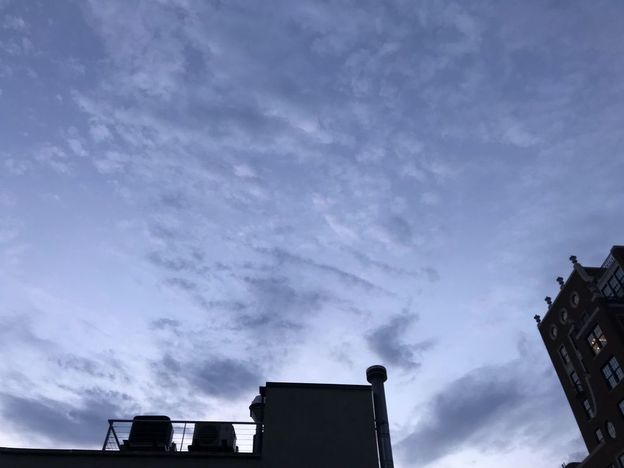 Photo by Nancy Kopans Photo by Nancy Kopans Nature is ever at work building and pulling down,… keeping everything whirling and flowing, allowing no rest but in rhythmical motion, chasing everything in endless song out of one beautiful form into another. – John Muir During a recent forest bathing walk a participant wondered whether “motion = life”. I have pondered this observation, thinking about how not everything alive is in obvious motion. Yet, on closer examination there is motion – a heartbeat, cellular activity, the vascular activity of plants. Perhaps it is this sense of “motion = life” that leads people to comment on how alive the city is, how it has energy, with its buzz of activity – people walking, taxis zooming, neon signs blinking -- like a giant organism. There are few better ways to experience a city and its whirl of motion than on a bicycle. On a bike one moves fast enough to get somewhere, but slow enough to see what’s around. And beyond seeing, there’s what’s experienced. There’s no glass or metal to separate us from surroundings, and with speed quickened from the pace of walking, senses become alert -- the sight of pedestrians stepping into a nearing intersection with the changing of a light, the feel of the breeze (even on a hot, muggy summer day), the sound of a siren somewhere. Streets become like a river, the bike like a kayak navigating white water. Being in motion, the turning of wheels propelled by the force of pedaling, seems to conjure the motion all around while making oneself a part of that motion too. There’s a sense of keeping time, the rhythmic motion of wheels spinning round, the rhythm of people walking, of cars moving, stopping at red lights, moving at green, creating a choreographed dance of people going places, everyone at their own rhythm, but collectively like a grand percussion symphony. The compactness of the city becomes apparent. Neighborhoods awkward to connect on a grid, such as a trip diagonally across town, or identified as geographically distinct zones (Uptown, Midtown, Downtown, East Side, West Side) can be traversed or connected within minutes, while allowing the rider to see all that is in between, stitching together the entire pattern of the city rather than starting at Point A and popping up at Point B, as in the case of a subway, with no clue of what’s in between. With this comes a feeling of independence, of being liberated from the constraints of the contained pods of subways and cars, with the vicissitudes of their interior space, and the slower pace of walking, even at the speed of a New Yorker still slower than on a bike, If distances are felt, so too are the city’s gradients. The paved-over hills and valleys that we are blind to when in a car, bus, or subway become apparent and experienced – a felt reading of the terrain. Biking puts the “hill” back in Murray Hill, Lenox Hill, and Carnegie Hill. And even in 94 degree soupy muggy weather, there’s a breeze. But if there’s freedom on a bike, there’s also a connection to civilization, and in this way biking in the city seems like a pure expression of what it is to be alive and human in a city. A bike after all is forged from metal, pure Vulcan (albeit from earth-sourced element) technology, and pairs beautifully with pavement for a smooth, human-propelled ride, a blending of the natural, ever-moving creatures that we are and technology. Although I’ve done a lot of road riding, including a self-guided cross country trip with a pal and a NYC-New Orleans self-guided trip with another pal, much of my riding these days is via Citibike, New York City’s bike share service. Citibikes are hearty 3-speeders with upright handlebars. They remind me of my childhood bike, with its banana shaped seat, handlebar basket, and plastic streamers radiating from the handlebar tips (how they moved in the wind!). What joy in that memory, awakened when I’m on a Citibike. My own Rosebud. I commute to—and when the daylight is long—from work by Citibike a few days a week. According to my Citibike app dashboard, I’ve gone on 605 rides, lasting collectively 266 hours (time much better spent than in a subway or taxi!), with aggregate mileage thus far of 1,988. That’s just about the distance from New York City to Cheyenne, Wyoming. There are days when I like to imagine that I’m on a stretch of road along that route. On a bicycle, imagination is free to roam.
0 Comments
 Sanya circumnavigation crew member Catherine North at North Cove Marina Sanya circumnavigation crew member Catherine North at North Cove Marina New York City is surrounded by wilderness--REAL wilderness, not the "urban jungle" or cut-throat work culture of high finance on Wall Street. The waters that surround New York and connect it to far away places offer a vast, undeveloped environment beyond the control of humankind. And what better way to experience this expanse than by sail boat? Docked until June 25 at the North Cove Marina in Battery Park City, and at other times this week at Liberty Landing Marina across the Hudson in Jersey City, are a dozen 70-foot racing yachts preparing to embark on the eighth and final leg--the 2,000 miles from New York to Derry-Londonderry--of a year-long race around the world. The Clipper Race is a 40,000 nautical mile race created by Sir Robin Knox-Johnson, the first person to sail solo non-stop around the world. Knox-Johnson recognized that more people have climbed Mount Everest than sailed around the world and was motivated to change this. With the aim of opening adventure sailing to a wider audience, the race invites everyday people to participate and is now in its eleventh season. A friend, Catherine North, is crew member for Sanya Serenity one of the twelve boats in the race. While some crew members participate in only one of the eight legs, Catherine is on board for the full ride. I was fortunate to be able to spend some time with her during her stopover in New York and to learn more about her breathtaking adventure, an adventure she describes as teaching her even more about herself than it has taught her about sailing. The race started last July in Liverpool, with with stopovers in Uruguay, South Africa, Australia, China, Seattle, and--now--New York. And along the way, the fleet made two Equator crossings, traveled along the Tradewinds, through the Doldrums, across the Atlantic and the South Atlantic, around the Cape of Good Hope, amid 80-foot swells and 70 mile-per-hour winds, through the South and East China Seas, across the International Date Line, across the Pacific, through the Panama Canal and the Caribbean, and on to New York, before heading along the Gulf Stream and Labrador Current on the final leg across the Atlantic. If you have a chance, check out the Clipper Race fleet in our nearby harbor (open tours are available until the 23rd). And even if you aren't able to see the fleet, invite your imagination to carry you across the city's nearby water, out through the harbor and on towards distant lands. Recent posts--Overview and HwyH2O--tuned into the perspective of looking down from above. Now let's shift our perspective 180 degrees and look up. After a warm spring Saturday spent mostly in Central Park, I returned home for dinner with the intention of returning to the park to enjoy twilight. But, by the time dinner was over I had lost my motivation. With my teenage daughter absorbed in end-of-semester exam prep and paper writing, I felt like being nearby. Had we a porch or patio, I would have delighted in stepping out onto it to enjoy the warm spring evening while my daughter continued with her homework indoors. One of the challenges of living in a city like New York is that it's not so easy to step outside from our homes. We apartment dwellers can't just open a door and walk onto a patio, lawn, field, or forest. Going outside is a production, requiring walking down flights of stairs, or a ride in an elevator. A favorite anecdote highlights this difference. I was in the country with my girls, at a house with a sliding door leading to an outside deck. My older daughter, who must have been about five at the time, pulled the door open and stepped outside, shut the door, then pulled it open again and stepped back inside, and repeated this several times, all the while saying, "Inside. Outside. Inside. Outside." A city kid, she was marveling at the realization that she so easily could transition from indoors and outdoors, a transition that is far more complex in her city home. When the days are getting longer and the air is warmer, I miss the ability to just step outside. I begin to feel a bit out of sorts, claustrophobic perhaps, as if entombed, and think about growing up in a leafy New York suburb. As I kid on an evening like this I likely would be playing kickball with the neighboring kids until our mothers called out for us to come home for dinner. We'd quickly chow down our meals and run back outside to continue the game until near darkness. No longer motivated to walk the few blocks to the park, I decided to head to the roof of my building, a flight of stairs up from my apartment. The building's roof is unfinished, and the view would not be considered exceptional. There's no direct view of the sunrise or sunset, no view of water or a park. A small, low-slung building, we are surrounded by larger buildings blocking any possibility of seeing the horizon. But the view upward is not blocked. My initial intent was to read, and although the book I'm reading is engaging, a voice inside me kept saying, "notice where you are." I put the book down, reclined in my on-the-ground adjustable hiking seat, and began to notice the sky. Layers of clouds moved across the great blue expanse, with clouds higher up illuminated by the setting sun, giving them yellow-pink tinge. Grayer clouds below portended predicted rain. And all the while, in a faint rhythm of surges and releases, a warm breeze enveloped me and let go, the same wind that was making the clouds move, the same wind that was making the branches of trees wave in a penthouse garden across the street. Every few minutes a plane crossed the sky, people in motion within a sky in motion. A helicopter buzzed across at a distance, like a mechanical firefly. As the daylight dimmed, lights in apartments begin to flick on. I stood up to wander about and from a new viewpoint, no longer blocked by a neighboring building, could see the moon in the south east sky, a halo surrounding its glow. Ever in a cycle of change, it was now a waxing gibbous, but in a few days would be a full moon, May's "Full Flower Moon". The world around me was in a cycle of motion and change. For over an hour, I looked upward from the unadorned rooftop, enchanted by the movement above and around me, seeing it with my eyes, feeling the warm wind touch my skin. The nearby buildings seemed small. The sky felt infinite.  Running around the Central Park Reservoir this evening, I noticed the stunning cherry blossoms in full bloom. Like delicate pompoms in shades of white, pink, and deeper pink, the clusters of flowers with their smooth, silky small petals decorated the trees' contrasting dark, thick and cracked bark. A strong breeze burst across the scene. The cherry tree branches waved, and petals began to fall. Like snowflakes, each one of the hundreds in motion found its own way to the ground, in its own dance of drifting, twirling, fluttering, and spinning, a collective ballet of pearly pastel petals, like tiny ballerinas in pink slippers. Enchanted by the beauty, I also felt a tinge of melancholy. Time was passing. With each petal dropping the flowers were slowly fading. Beauty and death, hand in hand. ---- Blossoming cherry- gentle breeze wafted away a pink cloud --Marinko Kovačević Cherry blossoms the old woman’s appearance as a young girl --Dietmar Tauchner My heart too is floating through the air – cherry blossoms --Paul Smith |
About this Blog
Hi! I'm Nancy Kopans, founder of Urban Edge Forest Therapy. Join me on an adventure to discover creative ways to connect with nature in your daily life, ways that are inspired by urban surroundings that can reveal unexpected beauty, with the potential to ignite a sense of wonder. Archives
April 2023
Categories
All
|


 RSS Feed
RSS Feed